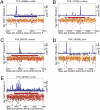Whole-genome sequencing and microarray analysis of ex vivo Plasmodium vivax reveal selective pressure on putative drug resistance genes
- PMID: 21037109
- PMCID: PMC2993397
- DOI: 10.1073/pnas.1003776107
Whole-genome sequencing and microarray analysis of ex vivo Plasmodium vivax reveal selective pressure on putative drug resistance genes
Abstract
Plasmodium vivax causes 25-40% of malaria cases worldwide, yet research on this human malaria parasite has been neglected. Nevertheless, the recent publication of the P. vivax reference genome now allows genomics and systems biology approaches to be applied to this pathogen. We show here that whole-genome analysis of the parasite can be achieved directly from ex vivo-isolated parasites, without the need for in vitro propagation. A single isolate of P. vivax obtained from a febrile patient with clinical malaria from Peru was subjected to whole-genome sequencing (30× coverage). This analysis revealed over 18,261 single-nucleotide polymorphisms (SNPs), 6,257 of which were further validated using a tiling microarray. Within core chromosomal genes we find that one SNP per every 985 bases of coding sequence distinguishes this recent Peruvian isolate, designated IQ07, from the reference Salvador I strain obtained in 1972. This full-genome sequence of an uncultured P. vivax isolate shows that the same regions with low numbers of aligned sequencing reads are also highly variable by genomic microarray analysis. Finally, we show that the genes containing the largest ratio of nonsynonymous-to-synonymous SNPs include two AP2 transcription factors and the P. vivax multidrug resistance-associated protein (PvMRP1), an ABC transporter shown to be associated with quinoline and antifolate tolerance in Plasmodium falciparum. This analysis provides a data set for comparative analysis with important potential for identifying markers for global parasite diversity and drug resistance mapping studies.
Conflict of interest statement
The authors declare no conflict of interest.
Figures



References
-
- Mendis K, Sina B, Marchesini P, Carter R. The neglected burden of Plasmodium vivax malaria. Am J Trop Med Hyg. 2001;64(1–2 Suppl):97–106. - PubMed
-
- Kochar DK, et al. Severe Plasmodium vivax malaria: A report on serial cases from Bikaner in northwestern India. Am J Trop Med Hyg. 2009;80:194–198. - PubMed
Publication types
MeSH terms
Substances
Associated data
- Actions
Grants and funding
LinkOut - more resources
Full Text Sources
Other Literature Sources
Molecular Biology Databases
Research Materials

